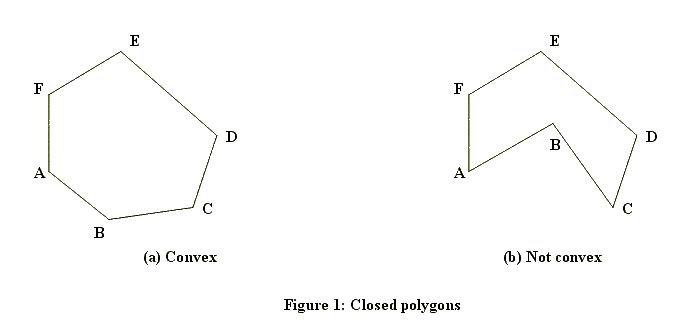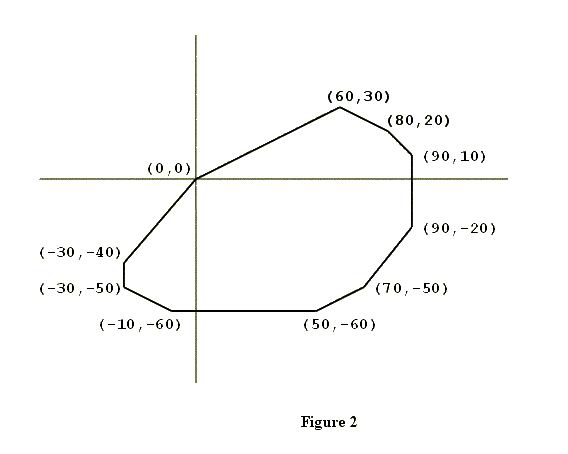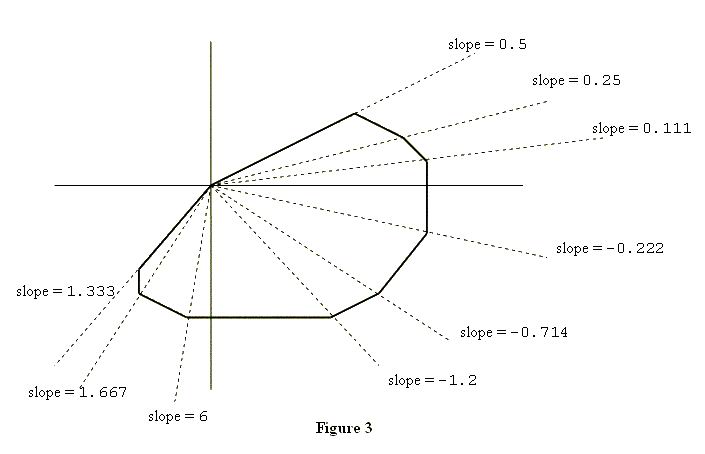POJ 2007--Scrambled Polygon(计算凸包,点集顺序)
| Time Limit: 1000MS | Memory Limit: 30000K | |
| Total Submissions: 10094 | Accepted: 4765 |
Description
A closed polygon is called convex if the line segment joining any two points of the polygon lies in the polygon. Figure 1 shows a closed polygon which is convex and one which is not convex. (Informally, a closed polygon is convex if its border doesn't have any "dents".) 
The subject of this problem is a closed convex polygon in the coordinate plane, one of whose vertices is the origin (x = 0, y = 0). Figure 2 shows an example. Such a polygon will have two properties significant for this problem.
The first property is that the vertices of the polygon will be confined to three or fewer of the four quadrants of the coordinate plane. In the example shown in Figure 2, none of the vertices are in the second quadrant (where x < 0, y > 0).
To describe the second property, suppose you "take a trip" around the polygon: start at (0, 0), visit all other vertices exactly once, and arrive at (0, 0). As you visit each vertex (other than (0, 0)), draw the diagonal that connects the current vertex with (0, 0), and calculate the slope of this diagonal. Then, within each quadrant, the slopes of these diagonals will form a decreasing or increasing sequence of numbers, i.e., they will be sorted. Figure 3 illustrates this point. 

Input
Output
Sample Input
0 0
70 -50
60 30
-30 -50
80 20
50 -60
90 -20
-30 -40
-10 -60
90 10
Sample Output
(0,0)
(-30,-40)
(-30,-50)
(-10,-60)
(50,-60)
(70,-50)
(90,-20)
(90,10)
(80,20)
(60,30)
Source
#include<iostream>
#include<algorithm>
#include<cmath>
#include<cstdio>
using namespace std;
const int maxn = ;
typedef struct point {
double x, y;
point() { }
point(double a, double b) {
x = a;
y = b;
}
point operator -(const point &b) const{
return point(x - b.x, y - b.x);
}
double operator *(const point &b)const {
return x*b.x + y*b.y;
}
}point;
point p[maxn];
int n=, res[maxn];
int top;//top模拟栈顶
bool cmp(point a, point b) {
if (a.y == b.y) return a.x < b.x;
return a.y < b.y;
}
bool multi(point p1, point p2, point p0) { //判断p1p0和p2p0的关系,<0,p1p0在p2p0的逆时针方向,>0,p1p0在p2p0的顺时针方向
return (p1.x - p0.x)*(p2.y - p0.y) >= (p2.x - p0.x)*(p1.y - p0.y);
}
void Graham(){
int i, len;//top模拟栈顶
sort(p, p + n, cmp);
top = ;
//少于3个点也就没有办法形成凸包
if (n == )return; res[] = ;
if (n == )return; res[] = ;
if (n == )return; res[] = ;
for (i = ; i < n; i++) {
while (top&&multi(p[i], p[res[top]], p[res[top - ]])) //如果当前这个点和栈顶两个点构成折线右拐了,就回溯到上一个点
top--; //弹出栈顶
res[++top] = i; //否则将这个点入栈
}
len = top;
res[++top] = n - ;
for (i = n - ; i >= ; i--) {
while (top!=len&&multi(p[i], p[res[top]], p[res[top - ]]))
top--;
res[++top] = i;
}
}
int main(void) {
int i, s;//s为起点坐标
while (scanf("%lf%lf", &p[n].x, &p[n].y)!=EOF)n++;
Graham();
for (s = ; s < top; s++) {
if (!p[res[s]].x && !p[res[s]].y) //找到原点
break;
}
for (i = s; i < top; i++) {
printf("(%.lf,%.lf)\n",p[res[i]].x, p[res[i]].y);
}
for (i = ; i < s; i++) {
printf("(%.lf,%.lf)\n", p[res[i]].x, p[res[i]].y);
}
return ;
}
最新文章
- Load Runner录制C/S客户端
- WinForm------GridControl右键添加动态菜单
- [C#]如何使用ThreadPool
- 20145308刘昊阳 《Java程序设计》第4周学习总结
- Linux下的shell编程(一)BY 四喜三顺
- eclipse SDK更新管理器安装插件
- a mystrious max subquence sum
- Git快速上手 : Tortoise工具使用
- jQuery整理笔记2----jQuery选择整理
- 【C语言探索之旅】 第一部分第十课:练习题+习作
- Ubuntu VPN PPTP 连接要选上这个啊
- ENetwork Basic Configuration PT Practice SBA
- linux子系统折腾记 (二)
- Generative Adversarial Nets[content]
- Http协议常见状态码
- Nginx详解十六:Nginx场景实践篇之缓存服务
- Elasticsearch冷热集群搭建
- python之路——9
- IP分组交付和转发
- React Native 填坑一